#waters of change
Text
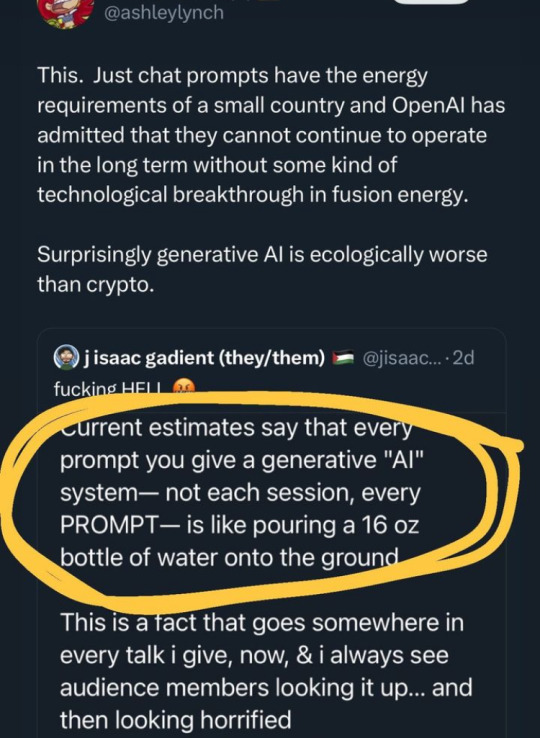
#ai#ai art#climate change#ecology#ecocide#water rights#land back#respect water treaties with First Nations#wasteland#waste#waste fraud and abuse#desertification
62K notes
·
View notes
Text
As relentless rains pounded LA, the city’s “sponge” infrastructure helped gather 8.6 billion gallons of water—enough to sustain over 100,000 households for a year.
Earlier this month, the future fell on Los Angeles. A long band of moisture in the sky, known as an atmospheric river, dumped 9 inches of rain on the city over three days—over half of what the city typically gets in a year. It’s the kind of extreme rainfall that’ll get ever more extreme as the planet warms.
The city’s water managers, though, were ready and waiting. Like other urban areas around the world, in recent years LA has been transforming into a “sponge city,” replacing impermeable surfaces, like concrete, with permeable ones, like dirt and plants. It has also built out “spreading grounds,” where water accumulates and soaks into the earth.
With traditional dams and all that newfangled spongy infrastructure, between February 4 and 7 the metropolis captured 8.6 billion gallons of stormwater, enough to provide water to 106,000 households for a year. For the rainy season in total, LA has accumulated 14.7 billion gallons.
Long reliant on snowmelt and river water piped in from afar, LA is on a quest to produce as much water as it can locally. “There's going to be a lot more rain and a lot less snow, which is going to alter the way we capture snowmelt and the aqueduct water,” says Art Castro, manager of watershed management at the Los Angeles Department of Water and Power. “Dams and spreading grounds are the workhorses of local stormwater capture for either flood protection or water supply.”
Centuries of urban-planning dogma dictates using gutters, sewers, and other infrastructure to funnel rainwater out of a metropolis as quickly as possible to prevent flooding. Given the increasingly catastrophic urban flooding seen around the world, though, that clearly isn’t working anymore, so now planners are finding clever ways to capture stormwater, treating it as an asset instead of a liability. “The problem of urban hydrology is caused by a thousand small cuts,” says Michael Kiparsky, director of the Wheeler Water Institute at UC Berkeley. “No one driveway or roof in and of itself causes massive alteration of the hydrologic cycle. But combine millions of them in one area and it does. Maybe we can solve that problem with a thousand Band-Aids.”
Or in this case, sponges. The trick to making a city more absorbent is to add more gardens and other green spaces that allow water to percolate into underlying aquifers—porous subterranean materials that can hold water—which a city can then draw from in times of need. Engineers are also greening up medians and roadside areas to soak up the water that’d normally rush off streets, into sewers, and eventually out to sea...
To exploit all that free water falling from the sky, the LADWP has carved out big patches of brown in the concrete jungle. Stormwater is piped into these spreading grounds and accumulates in dirt basins. That allows it to slowly soak into the underlying aquifer, which acts as a sort of natural underground tank that can hold 28 billion gallons of water.
During a storm, the city is also gathering water in dams, some of which it diverts into the spreading grounds. “After the storm comes by, and it's a bright sunny day, you’ll still see water being released into a channel and diverted into the spreading grounds,” says Castro. That way, water moves from a reservoir where it’s exposed to sunlight and evaporation, into an aquifer where it’s banked safely underground.
On a smaller scale, LADWP has been experimenting with turning parks into mini spreading grounds, diverting stormwater there to soak into subterranean cisterns or chambers. It’s also deploying green spaces along roadways, which have the additional benefit of mitigating flooding in a neighborhood: The less concrete and the more dirt and plants, the more the built environment can soak up stormwater like the actual environment naturally does.
As an added benefit, deploying more of these green spaces, along with urban gardens, improves the mental health of residents. Plants here also “sweat,” cooling the area and beating back the urban heat island effect—the tendency for concrete to absorb solar energy and slowly release it at night. By reducing summer temperatures, you improve the physical health of residents. “The more trees, the more shade, the less heat island effect,” says Castro. “Sometimes when it’s 90 degrees in the middle of summer, it could get up to 110 underneath a bus stop.”
LA’s far from alone in going spongy. Pittsburgh is also deploying more rain gardens, and where they absolutely must have a hard surface—sidewalks, parking lots, etc.—they’re using special concrete bricks that allow water to seep through. And a growing number of municipalities are scrutinizing properties and charging owners fees if they have excessive impermeable surfaces like pavement, thus incentivizing the switch to permeable surfaces like plots of native plants or urban gardens for producing more food locally.
So the old way of stormwater management isn’t just increasingly dangerous and ineffective as the planet warms and storms get more intense—it stands in the way of a more beautiful, less sweltering, more sustainable urban landscape. LA, of all places, is showing the world there’s a better way.
-via Wired, February 19, 2024
#california#los angeles#water#rainfall#extreme weather#rain#atmospheric science#meteorology#infrastructure#green infrastructure#climate change#climate action#climate resilient#climate emergency#urban#urban landscape#flooding#flood warning#natural disasters#environmental news#climate news#good news#hope#solarpunk#hopepunk#ecopunk#sustainability#urban planning#city planning#urbanism
14K notes
·
View notes
Text


fishing trip day 2 & 3 🎣🍀
#day 2 & 3 are good they actually catch soime fish#bakugo is wet in the 1st one cuz he fell into the water he got too excited over catching a tiny fish#also i didnt mention that in the 1st one but they try not to use their quirks during this trip :-) and no phones either#JUST TWO GIRLS AND MOTHER NATURE they do watch tiktoks on their 5th day sorryyyyyyyyyyy#they use their phones for photos though because they know mrs. bakugo would get upset if she didnt get to add a photo to her album#ugh losers#bnha#deku#midoriya izuku#bakugo katsuki#as you can see idgaf about bakcground and i dont think that will change anytime soon im too lazy to study that dimension of art :(#which is so dumb#au:#fishing trip#did i tag the first one
3K notes
·
View notes
Text
something about how the disability rights movement got watered down, in people's eyes, from "we demand that buildings are built to physically accommodate us, eg with ramps" to "there's nothing we can do about the world around us, but it would be nice if people were more accepting of seeing people stim"
#'you can't autism-proof a bright summer day' but you can plant trees! why are our cities so tree-less? how do we view trees as a society?#ugh i don't know how to articulate but it reminds#of like. so many trends#subcultures watered down to aesthetics#the focus on implicit bias over structural change#praxis being unimportant#like soooo many different threads of society have something equivalent
5K notes
·
View notes
Text
Accidental Villain Lair Acquisition
Team Phantom fleed Amity after a bad run with GIW. They found themselves in Gotham, then proceed to discover some interesting things underneath the city.
There is a natural spring of ectoplasm, for one. Not as pure as realms quality, but beggers choosers and whatever.
Then there's the messed up group of enthralled liminals too.
In other words, the court of owls are not having a good time at all. And Team Phantom accidentally become the new court. Yay...?
Bonus:
Danny:if I get a penny every time I gained the right to rule by rite of conquest, I'll have two. Which isn't a lot but... Why the fudge does this keep happening???
#dcxdp#there's not enough court of owls in this phandom and it has to be changed#Danny is communicating with the talons via chirping and thrilling#they adore their new master#also like#the lead researchers in dionesium aka main component of Lazarus water#are three scientist known as The Doctors Three#which.#is not Maddie Jack and Vald. but.
1K notes
·
View notes
Text
the other fish when it is time to feed them: Ah, dinner time? Splendid.
this one fish in particular: FOOD TIME!! FOOD TIME!!! OH BOY OH BOY OH BOY YES YES YES FOOD YES FOOD
love that guy
#goldfish#i love common goldfish....#tho I need to get some plants for their tank to suck up some nitrates#so i dont have to do water changes as often#misc
2K notes
·
View notes
Note
I'm sorry, just sent in 62 for the ask game because I'd overlooked that it's the amazing scifi thing!
Soooo 63?

(ID in ALT text)
okay so... you know whats really funny here. i think made this while for the first time polls popped up on tumblr. and i had this werid idea of like... "choose your adventure" kind of story telling. but... lets be honest i don't have much... time to draw all the options?
but this is still like... a sort of darker AU which is deer to my heart. and till today i don't know if they should have a happy end or not.
sokka got shipwrecked. and to make his situation even worse zuko poped up and and took a bite of him.
the whole siren idea is more based on the sinister one. the one drowning and eating seamen. and zuko is now out to eat sokka.
i have some plot lines written out.
-sokka playing with zuko a game of riddles to buy himself some more time
-zuko being unable to stay in the sun so sokka has to decide if he lest him take shelter underneath his make shift raft or lure him out of there to burn him.
at the end sokka does get saved and can escape for some time?
because zuko did end up biting him. and now sokka cant stop hearing him in his head, and zuko can still follow him. so... watch out sokka! zuko is on his way to eat you up but i still don't know if he means it literally or in a more plessurable way...
#chip!ask#wip ask game#meremay au but its january#sokka#zuko#mere!zuko#i honestly... i do like zukos designe for this#not that it is visible here and it slightly changed later on#but he doesn't have a tail!#he does have legs but similar to jelly fish he can like extend appandeges out that are like his fins?#so yeha... he needs to be near water othervise he dreis out to quickly but... he can follow sokka on land.#sokka: hahah... i am screwed
3K notes
·
View notes
Text
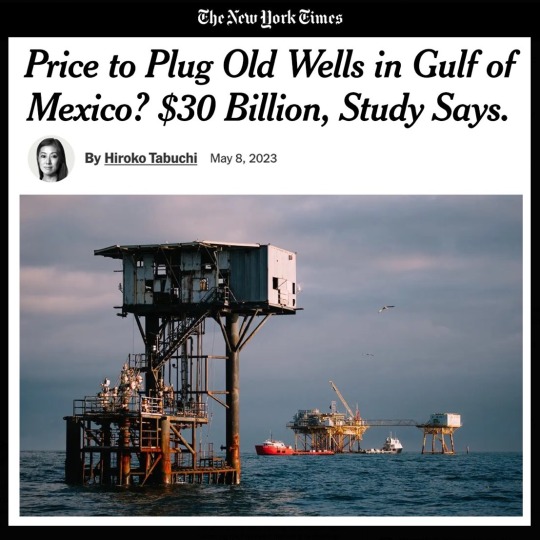
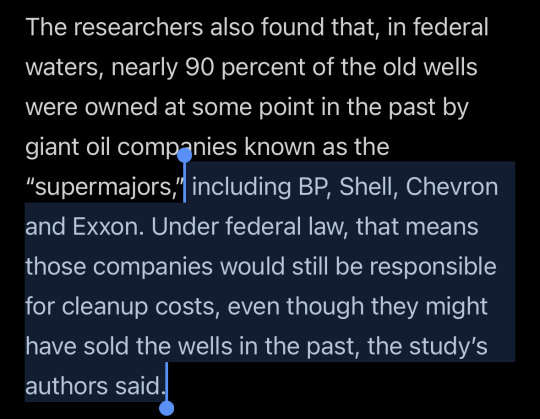
Source
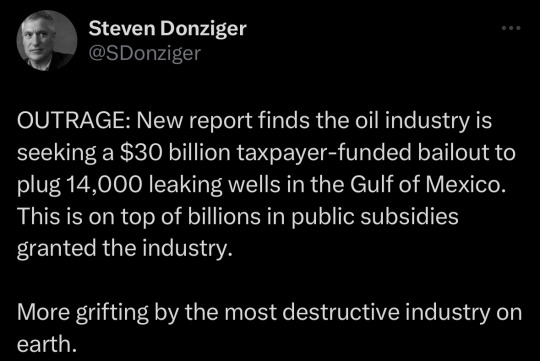
#climate change#fossil fuels#politics#us politics#government#the left#environment#water#clean water#energy#twitter post#progressive#green new deal#ban fossil fuels#environmentalism#environmental justice
12K notes
·
View notes
Text
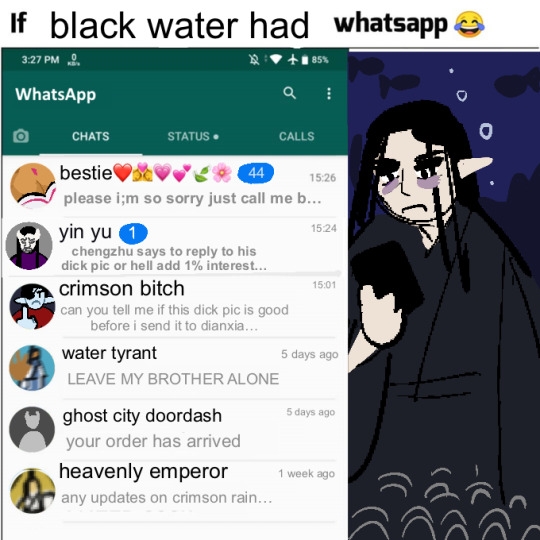
#sqx changed her name in his phone and she never changed it back#lmao#doodle#tgcf meme#tian guan ci fu#hob#heaven official’s blessing#beefleaf#he xuan#ming yi#shi qingxuan#shi wudu#hua cheng#yin yu#jun wu#my art#art#tgcf shitpost#black water sinking ships
2K notes
·
View notes
Text
Testing out Mother-Moonpool theory actually where moonpaw comes from the moonpool

Also introducing my version of moonpaw ...... warrior fandom's adopted daughter we stole from the erins

#moonpaw#art#warrior cats#changing skies#is that the new arc idk#moonpool#ignore how im just . rlly bad at drawing water LOL
1K notes
·
View notes
Text

Lan Wangji Goes To Lotus Pier AU: Part 1: Dread on Arrival
(Part 2)
#poorly drawn mdzs#mdzs#lan wangji#jiang fengmian#jiang cheng#wei wuxian#Yungmeng Jiang Training Arc AU#MDZS AU#The AU name for this idea is something I am 100% willing to change if someone has a better one.#There will be at least 2-3 more comics so *please*. Ideas and feedback welcome.#The core idea behind this AU is that LWJ goes to study with the Yunmeng Jiang sect instead of JC and WWX going to Cloud Recess#But why? Well I imagine Lan Xichen set it up to give LWJ a challenge (more social than skill based) and LWJ rose to it (begrudgingly)#Sort of a 'You've mastered so many Lan techniques but Other Sects have styles that are worth learning.' set up.#Lan Qiren agrees mostly on the basis that...well it's LWJ. Yunmeng Jiang is unruly but LWJ is beyond that riff-raff. He'll rise above it.#This is the story of a boy who thrives on routine and rules spending time in a place that is his apparent antithesis.#Also it is so warm there. He is used to it being cold and what do you MEAN just take off some of my layers?#I just want to see him struggle and flail in many situations. And get him in Jiang Purple. Is that so wrong of me?#(Soaking wet JC is part of my 'JC was born to swim; forced to hold a sword' agenda. Do not remove him from the water)#((Politeness notes: JFM would *not* call LWJ 'lan wangji' nor would LWJ be vocally impolite to a sect leader.))
2K notes
·
View notes
Text
Things Biden and the Democrats did, this week #20
May 24-31 2024
The EPA awards $900 million to school districts across the country to replace diesel fueled school buses with cleaner alternatives. The money will go to 530 school districts across nearly every state, DC, tribal community, and US territory. The funds will help replace 3,400 buses with cleaner alternatives, 92% of the new buses will be 100% green electric. This adds to the $3 billion the Biden administration has already spent to replace 8,500 school buses across 1,000 school districts in the last 2 years.
For the first time the federal government released guidelines for Voluntary Carbon Markets. Voluntary Carbon Markets are a system by which companies off set their carbon emissions by funding project to fight climate change like investing in wind or solar power. Critics have changed that companies are using them just for PR and their funding often goes to projects that would happen any ways thus not offsetting emissions. The new guidelines seek to insure integrity in the Carbon Markets and make sure they make a meaningful impact. It also pushes companies to address emissions first and use offsets only as a last resort.
The IRS announced it'll take its direct file program nationwide in 2025. In 2024 140,000 tax payers in 12 states used the direct file pilot program and the IRS now plans to bring it to all Americans next tax season. Right now the program is only for simple W-2 returns with no side income but the IRS has plans to expand it to more complex filings in the future. This is one of the many projects at the IRS being funded through President Biden's Inflation Reduction Act.
The White House announced steps to boost nuclear energy in America. Nuclear power in the single largest green energy source in the country accounting for 19% of America's total energy. Boosting Nuclear energy is a key part of the Biden administration's strategy to reach a carbon free electricity sector by 2035. The administration has invested in bring the Palisades nuclear plant in Michigan back on-line, and extending the life of Diablo Canyon in California. In addition the Military will be deploying new small modular nuclear reactors and microreactors to power its installations. The Administration is setting up a task force to help combat the delays and cost overruns that have often derailed new nuclear projects and the Administration is supporting two Gen III+ SMR demonstration projects to highlight the safety and efficiency of the next generation of nuclear power.
The Department of Agriculture announced $824 million in new funding to protect livestock health and combat H5N1. The funding will go toward early detection, vaccine research, and supporting farmers impacted. The USDA is also launching a nation wide Dairy Herd Status Pilot Program, hopefully this program will give us a live look at the health of America's dairy herd and help with early detection. The Biden Administration has reacted quickly and proactively to the early cases of H5N1 to make sure it doesn't spread to the human population and become another pandemic situation.
The White House announced a partnership with 21 states to help supercharge America's aging energy grid. Years of little to no investment in America's Infrastructure has left our energy grid lagging behind the 21st century tech. This partnership aims to squeeze all the energy we can out of our current system while we rush to update and modernize. Last month the administration announced a plan to lay 100,000 miles of new transmission lines over the next five years. The 21 states all with Democratic governors are Arizona, California, Colorado, Connecticut, Delaware, Hawaii, Illinois, Kentucky, Maine, Maryland, Massachusetts, Michigan, New Jersey, New Mexico, New York, North Carolina, Oregon, Pennsylvania, Rhode Island, Washington, and Wisconsin.
The Department of Transportation announced $343 million to update 8 of America's oldest and busiest transportation stations for disability accessibility. These include the MBTA's the Green Line's light-rail B and C branches in Boston, Cleveland's Blue Line, New Orleans' St. Charles Streetcar route, and projects in San Francisco and New York City and other locations
The Department of interior announced two projects for water in Western states. $179 million for drought resilience projects in California and Utah and $242 million for expanding water access in California, Colorado and Washington. The projects should help support drinking water for 6.4 million people every year.
HUD announced $150 million for affordable housing for tribal communities. This adds to the over $1 billion dollars for tribal housing announced earlier in the month. Neil Whitegull of the Ho-Chunk Nation said at the announcement "I know a lot of times as Native Americans we've been here and we've seen people that have said, ‘Oh yeah, we'd like to help Indians.’ And they take a picture and they go away. We never see it, But there's been a commitment here, with the increase in funding, grants, and this administration that is bringing their folks out. And there's a real commitment, I think, to Native American tribes that we've never seen before."
Secretary of State Antony Blinken pledged $135 million to help Moldavia. Since the outbreak of Russia's war against neighboring Ukraine the US has given $774 million in aid to tiny Moldavia. Moldavia has long been dependent on Russian energy but thanks to US investment in the countries energy security Moldavia is breaking away from Russia and moving forward with EU membership.
The US and Guatemala launched the "Youth With Purpose” initiative. The initiative will be run through the Central America Service Corps, launched in 2022 by Vice President Harris the CASC is part of the Biden Administration's efforts to improve life in Central America. The Youth With Purpose program will train 25,000 young Guatemalans and connect with with service projects throughout the country.
Bonus: Today, May 31st 2024, is the last day of the Affordable Connectivity Program. The program helped 23 million Americans connect to the internet while saving them $30 to $75 dollars every month. Despite repeated calls from President Biden Republicans in Congress have refused to act to renew the program. The White House has worked with private companies to get them to agree to extend the savings to the end of 2024. The Biden Administration has invested $90 Billion high-speed internet investments. Such as $42.45 billion for Broadband Equity, Access, and Deployment, $1 billion for the The Middle Mile program laying 12,000 miles of regional fiber networks, and distributed nearly 30,000 connected devices to students and communities, including more than 3,600 through the Tribal Broadband Connectivity Program
#Thanks Biden#joe biden#us politics#politics#American politics#climate change#climate action#nuclear power#h5n1#accessibility#tribal communities#Moldavia#Guatemala#water#internet
1K notes
·
View notes
Text
Legit though, we should start turning ecosystem restoration and work to make our world more tolerant to the effects of climate change into annual holidays and festivals
Like how just about every culture used to have festivals to celebrate the beginning of the harvest or its end, or the beginning of planting, or how whole communities used to host barn raisings and quilting bees - everyone coming together at once to turn the work of months or years into the work of a few days
Humble suggestions for festival types:
Goat festival
Besides controlled burns (which you can't do if there's too much dead brush), the fastest, most effective, and most cost-efficient way to clear brush before fire season - esp really heavy dead brush - is to just. Put a bunch of goats on your land for a few days!
Remember that Shark Tank competitor who wanted to start a goat rental company, and everyone was like wtf? There was even a whole John Oliver bit making fun of the idea? Well THAT JUST PROVES THEY'RE FROM NICE WET PLACES, because goat rental companies are totally a thing, and they're great.
So like. Why don't we have a weekend where everyone with goats just takes those goats to the nearest land that needs a ton of clearing? Public officials could put up maps of where on public lands grazing is needed, and where it definitely shouldn't happen. Farmers and people/groups with a lot of acres that need clearing can post Goat Requests.
Little kids can make goat-themed crafts and give the goats lots of pets or treats at the end of the day for doing such a good job. Volunteers can help wrangle things so goats don't get where they're not supposed to (and everyone fences off land nowadays anyway, mostly). And the goats, of course, would be in fucking banquet paradise.
Planting Festival and Harvest Festival
Why mess with success??? Bring these back where they've disappeared!!! Time to swarm the community gardens and help everyone near you with a farm make sure that all of their seeds are sown and none of the food goes to waste in the fields, decaying and unpicked.
And then set up distribution parts of the festival so all the extra food gets where it needs to be! Boxes of free lemons in front of your house because you have 80 goddamned lemons are great, but you know what else would be great? An organized effort to take that shit to food pantries (which SUPER rarely get fresh produce, because they can't hold anything perishable for long at all) and community/farmer's markets
Rain Capture Festival
The "water year" - how we track annual rainfall and precipitation - is offset from the regular calendar year because, like, that's just when water cycles through the ecosystems (e.g. meltwater). At least in the US, the water year is October 1st through September 30th of the next year, because October 1st is around when all the snowmelt from last year is gone, and a new cycle is starting as rain begins to fall again in earnest.
So why don't we all have a big barn raising equivalent every September to build rain capture infrastructure?
Team up with some neighbors to turn one of those little grass strips on the sidewalk into a rain-garden with fall-planting plants. Go down to your local church and help them install some gutters and rain barrels. Help deculvert rivers so they run through the dirt again, and make sure all the storm drains in your neighborhood are nice and clear.
Even better, all of this - ESPECIALLY the rain gardens - will also help a ton with flood control!
I'm so serious about how cool this could be, yall.
And people who can't or don't want to do physical stuff for any of these festivals could volunteer to watch children or cook food for the festival or whatever else might need to be done!
Parties afterward to celebrate all the good work done! Community building and direct local improvements to help protect ourselves from climate change!
The possibilities are literally endless, so not to sound like an influencer or some shit, but please DO comment or reply or put it in the notes if you have thoughts, esp on other things we could hold festivals like this for.
Canning festivals. "Dig your elderly neighbors out of the snow" festivals. Endangered species nesting count festival. Plant fruit trees on public land and parks festival. All of the things that I don't know anywhere near enough to think of. Especially in more niche or extreme ecosystems, there are so many possibilities that could do a lot of good
#climate change#climate action#climate crisis#climate hope#solarpunk#hopepunk#hope posting#community building#ecosystem#ecosystem restoration#forest fire#fire prevention#flood#flood prevention#harvest#harvest festival#regenerative agriculture#modern farming#water conservation#meteorology#festival#not news#hope#climate optimism
3K notes
·
View notes
Text
Basically, my philosophy around disability fakers is: I would rather a thousand people fake a disability than have one disabled person suffer without care, aids, compassion, or any help.
#disability#disability advocacy#and there's a difference not many people seem to recognize between faking and realizing you don't have [x] problem...#...such as realizing you don't have [x] disorder because it is instead [y] disorder...#...or you haven't completely understood your care needs/your symptoms/what helps you...#...and some people see ANY change in your understanding of your disability as proof of maliciously faking...#...when i suppose in my personal experience people don't *maliciously* fake disability...#...i'm not saying it could never happen but that i don't think it's the *only* thing motivating people called fakers#i just think (like most everything) this is complex and nuanced because it's a *human* experience#like for me personally i /know/ i still have a lot to learn about my disabilities...#...like... i realized recently that my hands shouldn't be in AGONY when warm water is ran over them when it's SLIGHTLY cold inside or out...#...and i realized that i likely have a Noticable limb difference that needs checking out. does this sound like i'm faking...#...or that maybe i just didn't really explore my own needs and body because of a variety of factors?#i can assure you it is because i haven't really thought before about how i deserved to understand how to best help myself
4K notes
·
View notes
Text
NASA Inspires Your Crafty Creations for World Embroidery Day
It’s amazing what you can do with a little needle and thread! For #WorldEmbroideryDay, we asked what NASA imagery inspired you. You responded with a variety of embroidered creations, highlighting our different areas of study.
Here’s what we found:
Webb’s Carina Nebula
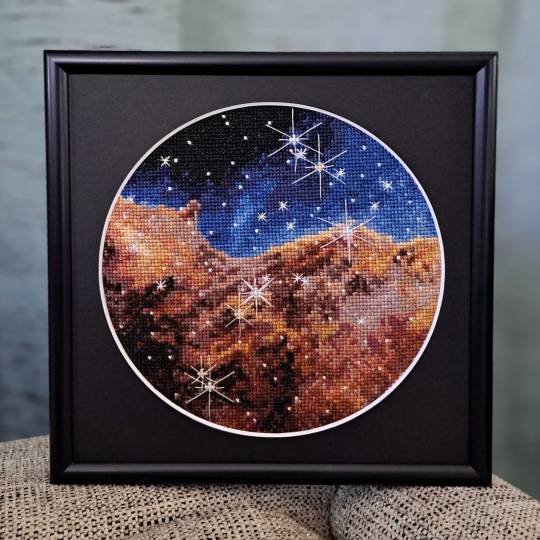
Wendy Edwards, a project coordinator with Earth Science Data Systems at NASA, created this embroidered piece inspired by Webb’s Carina Nebula image. Captured in infrared light, this image revealed for the first time previously invisible areas of star birth. Credit: Wendy Edwards, NASA. Pattern credit: Clare Bray, Climbing Goat Designs
Wendy Edwards, a project coordinator with Earth Science Data Systems at NASA, first learned cross stitch in middle school where she had to pick rotating electives and cross stitch/embroidery was one of the options. “When I look up to the stars and think about how incredibly, incomprehensibly big it is out there in the universe, I’m reminded that the universe isn’t ‘out there’ at all. We’re in it,” she said. Her latest piece focused on Webb’s image release of the Carina Nebula. The image showcased the telescope’s ability to peer through cosmic dust, shedding new light on how stars form.
Ocean Color Imagery: Exploring the North Caspian Sea
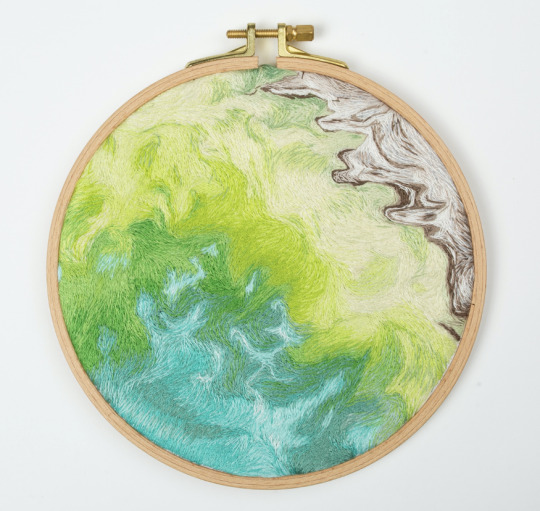
Danielle Currie of Satellite Stitches created a piece inspired by the Caspian Sea, taken by NASA’s ocean color satellites. Credit: Danielle Currie/Satellite Stitches
Danielle Currie is an environmental professional who resides in New Brunswick, Canada. She began embroidering at the beginning of the Covid-19 pandemic as a hobby to take her mind off the stress of the unknown. Danielle’s piece is titled “46.69, 50.43,” named after the coordinates of the area of the northern Caspian Sea captured by LandSat8 in 2019.

An image of the Caspian Sea captured by Landsat 8 in 2019. Credit: NASA
Two Hubble Images of the Pillars of Creation, 1995 and 2015
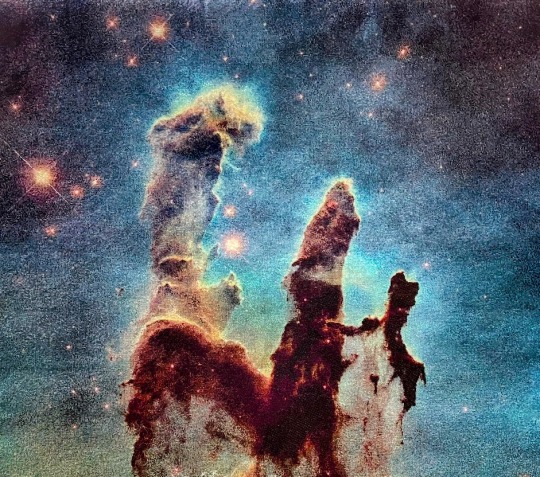
Melissa Cole of Star Stuff Stitching created an embroidery piece based on the Hubble image Pillars of Creation released in 1995. Credit: Melissa Cole, Star Stuff Stitching
Melissa Cole is an award-winning fiber artist from Philadelphia, PA, USA, inspired by the beauty and vastness of the universe. They began creating their own cross stitch patterns at 14, while living with their grandparents in rural Michigan, using colored pencils and graph paper. The Pillars of Creation (Eagle Nebula, M16), released by the Hubble Telescope in 1995 when Melissa was just 11 years old, captured the imagination of a young person in a rural, religious setting, with limited access to science education.

Lauren Wright Vartanian of the shop Neurons and Nebulas created this piece inspired by the Hubble Space Telescope’s 2015 25th anniversary re-capture of the Pillars of Creation. Credit: Lauren Wright Vartanian, Neurons and Nebulas
Lauren Wright Vartanian of Guelph, Ontario Canada considers herself a huge space nerd. She’s a multidisciplinary artist who took up hand sewing after the birth of her daughter. She’s currently working on the illustrations for a science themed alphabet book, made entirely out of textile art. It is being published by Firefly Books and comes out in the fall of 2024. Lauren said she was enamored by the original Pillars image released by Hubble in 1995. When Hubble released a higher resolution capture in 2015, she fell in love even further! This is her tribute to those well-known images.
James Webb Telescope Captures Pillars of Creation

Darci Lenker of Darci Lenker Art, created a rectangular version of Webb’s Pillars of Creation. Credit: Darci Lenker of Darci Lenker Art
Darci Lenker of Norman, Oklahoma started embroidery in college more than 20 years ago, but mainly only used it as an embellishment for her other fiber works. In 2015, she started a daily embroidery project where she planned to do one one-inch circle of embroidery every day for a year. She did a collection of miniature thread painted galaxies and nebulas for Science Museum Oklahoma in 2019. Lenker said she had previously embroidered the Hubble Telescope’s image of Pillars of Creation and was excited to see the new Webb Telescope image of the same thing. Lenker could not wait to stitch the same piece with bolder, more vivid colors.
Milky Way

Darci Lenker of Darci Lenker Art was inspired by NASA’s imaging of the Milky Way Galaxy. Credit: Darci Lenker
In this piece, Lenker became inspired by the Milky Way Galaxy, which is organized into spiral arms of giant stars that illuminate interstellar gas and dust. The Sun is in a finger called the Orion Spur.
The Cosmic Microwave Background
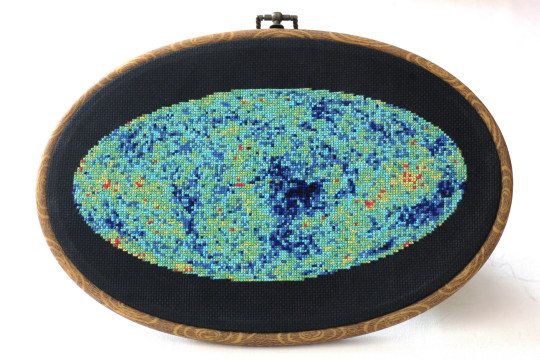
This image shows an embroidery design based on the cosmic microwave background, created by Jessica Campbell, who runs Astrostitches. Inside a tan wooden frame, a colorful oval is stitched onto a black background in shades of blue, green, yellow, and a little bit of red. Credit: Jessica Campbell/ Astrostitches
Jessica Campbell obtained her PhD in astrophysics from the University of Toronto studying interstellar dust and magnetic fields in the Milky Way Galaxy. Jessica promptly taught herself how to cross-stitch in March 2020 and has since enjoyed turning astronomical observations into realistic cross-stitches. Her piece was inspired by the cosmic microwave background, which displays the oldest light in the universe.

The full-sky image of the temperature fluctuations (shown as color differences) in the cosmic microwave background, made from nine years of WMAP observations. These are the seeds of galaxies, from a time when the universe was under 400,000 years old. Credit: NASA/WMAP Science Team
GISSTEMP: NASA’s Yearly Temperature Release

Katy Mersmann, a NASA social media specialist, created this embroidered piece based on NASA’s Goddard Institute for Space Studies (GISS) global annual temperature record. Earth’s average surface temperature in 2020 tied with 2016 as the warmest year on record. Credit: Katy Mersmann, NASA
Katy Mersmann is a social media specialist at NASA’s Goddard Space Flight Center in Greenbelt, Md. She started embroidering when she was in graduate school. Many of her pieces are inspired by her work as a communicator. With climate data in particular, she was inspired by the researchers who are doing the work to understand how the planet is changing. The GISTEMP piece above is based on a data visualization of 2020 global temperature anomalies, still currently tied for the warmest year on record.
In addition to embroidery, NASA continues to inspire art in all forms. Check out other creative takes with Landsat Crafts and the James Webb Space telescope public art gallery.
Make sure to follow us on Tumblr for your regular dose of space!
#NASA#creativity#fiber art#embroidery#art#art challenge#needlework#crafts#handmade#textile art#cross stitch#stitching#inspiration#inspo#Earth#Earth science#Hubble#James Webb Space Telescope#climate change#water#nebula#stars
6K notes
·
View notes
Text

guess who 😈
and I have this art with beta—
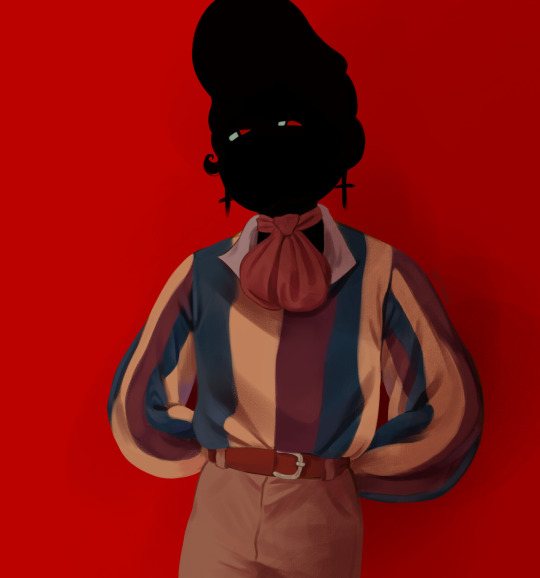
I also have a lot of sketches that I hope to finish in the near future (don't pay attention to the fact that there're a lot of Howdy here....)
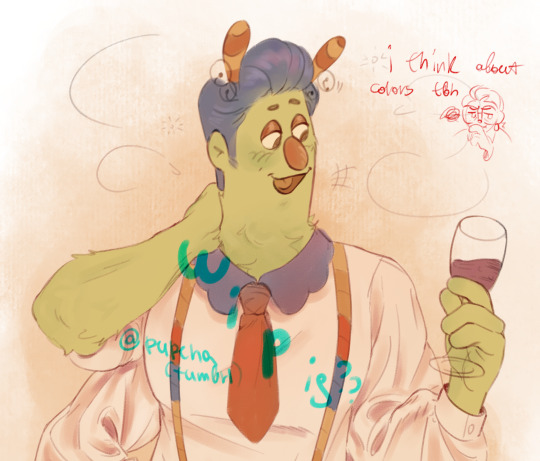



(hum)beta!Wally (eechy pspsps 🫴)


I don't know what else to show you, so I'll show you (the old ones) art for my mutual :]


Margo for @//thelone-copper ; (I don't know his name 😔🥄🥄🥄) for @//dxkjf
#Hooray I came back again.... two months later.... hm#you know I actually draw very often but most of the sketches seem very stupid to me to put them here—#yes the feeling of shame for my art. AGAIN ((i'm trying to get rid of this feeling))#ahem. let's change the subject#I hope you're doing well and eating well!! also don’t forget to drink water :]#please I love water so much.... such a refreshing taste smhhh#welcome home#welcome home wally#wally darling#howdy pillar#sketches#art#wally fanart#barnaby b beagle#beta wally
2K notes
·
View notes